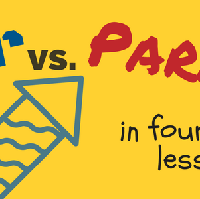
Making sense of por and para
Does the difference between por and para seem like a confusing set of arbitrary rules?
It may surprise you that it can all be boiled down to one basic pattern.
In these four lessons, I’ll show you how all the different uses of por and para follow the same pattern. And for each lesson, you can use the intuition trainer (above) to practice the concepts so you really get it.
Is it important to master por and para?
If you’re at beginner level, don’t worry about por and para. Your time is better spent just absorbing lots of Spanish. It’s not a big deal if you mix them up—native speakers can figure out what you mean.
Even at intermediate level, it’s not the most important thing to work on.
But beyond just wanting your Spanish to be perfect, there’s actually a good reason to master this distinction. This is one of the places where Spanish really carves the world up in a way that’s different from English. By mastering por and para, you gain a very expressive, native Spanish way to think and talk about the world.
So let’s transform what is otherwise a tedious memorization task into a fun, language learning adventure.
The key is to focus on concepts rather than translations. Both words translate into English in many ways (for, to, from, because of, as, by, etc.). But the core concepts are simple. Por and para are like yin and yang–they represent complementary concepts that actually have very little overlap in meaning.
Lesson 1: Place and direction
When dealing with place and direction, the distinction between por and para is very clear. Para has to do with destination; por with the route by which you get there. For example:
¿Para dónde? (To where? Where are you headed?) Destination
¿Por dónde? (Via where? By which route are you going?) Route
Voy para Machu Picchu por el Camino Inca. (I’m going to Machu Picchu via the Inca Trail.)
This use of por to mean via turns out to be very useful, even when you’re not talking about an actual, physical place:
Lo reservé por Internet. (I reserved it via the internet.) Via
Páseme esta información por correo electrónico. (Send me this information via email.) Via
When talking about place, por has a few other meanings closely related to via:
Tengo que pasar por los mostradores de facturación. (I have to go through check-in.) Through
Caminamos por el campo recogiendo la basura. (We walked around the field picking up trash.) Throughout
Finally, por has one other meaning related to place: it can be used to indicate approximate location.
Ese pueblo está por Bogotá. (That town is somewhere around Bogotá.) Around
Now use the intuition trainer quiz to practice the difference between route and destination.
Lesson 2: Dates and times
When dealing with dates and times, the pattern for por and para is almost identical to Lesson 1. Para has to do with a deadline or target date (destination), por has to do with a duration (route):
Estaré aquí para el viernes siguiente. (I’ll be here by next Friday.) Deadline
Estaré aquí por cinco semanas. (I’ll be here for five weeks.) Duration
Necesitamos el coche para el doce de diciembre; lo usaremos por dos meses. (We need the car by Dec. 12; we’ll use it for two months.)
Just as with place, por can also signify an approximate date (but only with dates, not with times).
La feria será por marzo. (The fair will be sometime around March.) Around
Notice that this complicates things a little, since now we can have two very similar statements:
Lo necesito para marzo. (I need it by March.) Target date
Lo necesito por marzo. (I need it sometime around March.) Around
The meanings are similar; using para gives a more precise endpoint.
Now use the intuition trainer quiz to practice the difference between target date and duration.
Lesson 3: Recipient vs. Exchange
Consider these examples:
Compré este regalo para ti. (I bought this gift for you.) Recipient
Compré este regalo por doscientos pesos. (I bought this gift for 200 pesos.) Exchange
Enseño esta clase para ustedes. (I’m teaching this class for you-all.) Recipient
Enseño esta clase por ti. (I’ll teach this class for you/in place of you.) Substitution
Do you see a similar pattern to Lessons 1 and 2?
Destination = target date = recipient: Para indicates an endpoint.
Route = duration = exchange: Por indicates a pathway.
One aspect of exchange and substution is equivalency, expressed in English by per:
Un kilo de manzanas por diez pesos. (A kilo of apples for ten pesos.) Exchange
Cincuenta kilómetros por hora. (Fifty kilometers per hour.) Per
Una vez por año. (Once per year.) Per
If recipient is taken more figuratively, it turns into a point of view.
Este regalo es para ti. (This gift is for you.) Recipient
Este regalo es demasiado caro para mí. (This gift is too expensive for me.) Point of view
Note that point of view doesn’t have to refer to a person.
Es un proyecto muy importante para nuestra agencia. (It’s a very important project for our agency.) Point of view
Es carísimo para una camiseta. (It’s extremely expensive for a t-shirt.) Point of view
Now use the intuition trainer quiz to practice the difference between exchange and recipient.
Lesson 4: Purpose vs. Cause
Consider these examples:
El bosque se quemó para despejar la tierra. (The forest was burned to clear the land.) Purpose
El bosque se quemó por la sequía. (The forest burned because of the drought.) Cause
Para is associated with purpose; por with cause. Notice that this lines right up with our main pattern: purpose = destination; cause = route.
But for English speakers, cause and purpose can seem confusingly similar. Consider:
¿Por qué estás en el hospital? (Why are you at the hospital?) Cause
¿Para qué estás en el hospital? (What are you at the hospital for?) Purpose
In English, these sentences are almost interchangeable. But, in Spanish, the distinction is more strongly maintained:
¿Por qué estás en el hospital? (Why are you at the hospital?)
Me rompí la pierna. (I broke my leg.) Cause
¿Para qué estás en el hospital? (What are you at the hospital for?)
Me van a enyesar la pierna. (To get a cast on my leg.) Purpose
A closely related meaning of por is on behalf of or for the sake of. These contrast with in order to (purpose) of para. For example:
¿Puedo hacer algo por ti? (Can I do anything for you?) On behalf of
¿Puedo hacer algo para ti? (Can I make anything for you?) Recipient
¿Puedo hacer algo para arreglarla? (Can I do anything to fix it?) In order to
Se negó a contestar por su dignidad. (For the sake of his dignity, he refused to answer.) For the sake of
Se negó a contestar para mantener el secreto. (In order to keep the secret, he refused to answer.) In order to
Note that in some situations the distinction between cause and purpose breaks down. For example, when the cause of an action is a desire:
Vine para verte. (I came to see you.) In order to
Vine por verte. (I came to see you.) For the sake of
These have the identical meaning.
Now use the intuition trainer quiz to practice the difference between cause and purpose.
Extra Lesson: Verbs followed by por
Now that you’re on your way to mastering por and para, there’s one more thing to be aware of: there are a number of verbs that take por as a preposition. For example:
¿Me tomas por estúpido? (Do you take me for an idiot.) Tomar por
Pregunta por la sección de damas. (Ask for the ladies’ section.) Preguntar por
If you squint at these, you can fit them into the core pattern. However, it’s useful to realize that these are set phrases. Tomar por means to take (something) for (something else) and preguntar por means to ask about or to ask after.
Here are some other common verbs that take por:
decidirse por: to decide on
disculparse por: to apologize for
interesarse por: to be interested in
luchar por: to struggle to
molestarse por: to bother about
preocuparse por: to worry about
rezar por: to pray for


